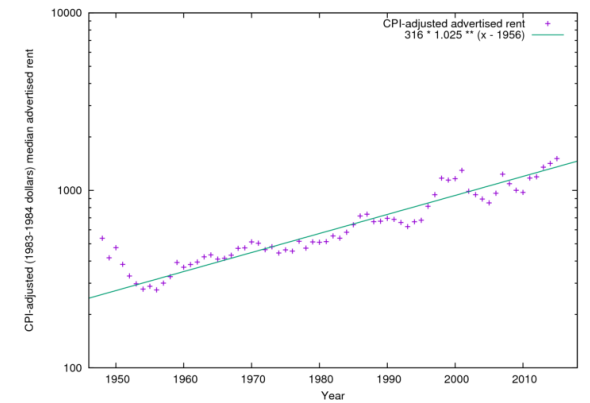Will the proposed rent stabilization law (rent control) increase average asking rents?
It is a common myth that rent control drives down the cost of rent controlled units, while causing a corresponding increase in advertised rent prices. Historical data on advertised rents in San Francisco publicized this year disproves this myth.

Advertised rents in the San Francisco Chronicle have increased an average of 6.6 percent since the 1950s, even after rent control’s introduction in 1979.
From the report linked above: “That, my friends, is 70 years of San Francisco housing prices. (asking prices, which aren’t the average rents) There are some ups and downs, but for the most part there is a very simple trend: 6.6 percent.” That has happened “every year, on average, since 1956. It was true before rent control; it was true after rent control.”
What do economists really say about rent control?
Much like the $15 minimum wage increase Mountain View passed last near, there is no consensus among economists about the economic impacts of rent control. Opponents still like to claim this however.
“Perhaps a majority (of economists), at least among the younger generation, would agree with the statement that a well-designed rent control program can be beneficial,” writes Richard Arnott, professor of economics at Boston College in a 1995 paper in the Journal of Economic Perspectives. Opposition from a previous generation of economists was informed by the “clearly harmful” effects of WWII era rent freezes, which Arnott calls “first generation” rent controls. “Clearly, second-generation rent controls are very different from a rent freeze,” he writes. The paper concludes that economists should reconsider any opposition to rent control systems.
Opponents often point to a 1992 a poll of the American Economic Association that found 93 percent of its members agreeing that “a ceiling on rents reduces the quality and quantity of housing.” However, the Mountain View Tenants Coalition’s rent stabilization ballot measure, and similar laws in 12 California cities, are far from a “ceiling on rents” The MVTC measure allows annual rent increases that are below the rate of inflation, and rent increases higher than inflation when expenses prevent landlords from making a fair return on their investment. It also doesn’t apply to new housing development, and therefore cannot discourage new housing development.
Even Paul Krugman of the New York Times has succumbed to parroting the 1992 poll as evidence of opposition to rent control from economists. Click here for a response to Krugman by Tenants Together.
Click here to download a very well written piece addressing myths about rent control by Timothy Collins, who for over seven years, “served as Executive Director and Counsel to the New York City Rent Guidelines Board. The primary work of our staff was to examine the effects of New York’s rent regulations on tenants, owners, the housing stock, the local economy, and our quality of life. This work was done by direct analysis of data made available from city and state agencies; direct surveys of tenants, landlords and vendors; reviews of studies prepared by industry, academic, and tenant organizations; and various government reports. Over the years, a wealth of information was examined and a clear picture has emerged: New York’s moderate rent regulations have had few, if any, of the negative side effects so confidently predicted by industry advocates. More important, rent regulations have been the single greatest source of affordable housing for middle‐ and low‐income households.”
How bad is the problem you are trying to address with this law?
Average asking rents have increased by an astounding 80 percent since 2009 in Mountain View. That’s a near doubling in only seven years. Landlords have clearly been in a position to take advantage of a housing shortage.

Red line: Average asking rents in Mountain View since 2008 compared to the region (blue dotted line). Source: City of Mountain View
Average asking rents in Mountain View over the last four years, by housing type:

Source: City of Mountain View
Not satisfied? Perhaps you need to hear a good debate on rent control:
Click here to listen to hear a landlord lobbyist and a rent control advocate duke it out on KQED’s Forum radio show.